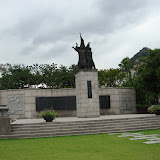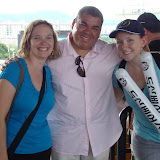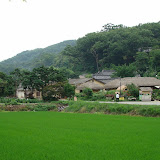exhausting 30+ hour journey back to my home in Florida. I have had a few days to enjoy the creature comforts of my own home as well as the happiness of being reunited with my husband. I am slowly beginning to reconnect with friends and family and am realizing – I have so so much to share with everyone! I can’t wait…okay, I can wait (it’s just two more weeks), but I’m very excited to see my new and old students and share stories with them too!
Monday 19 July 2010
The last few days were busy as always. Our final lectures at Korean University explored Korean culture, the Korean education system, and art history and were again rich, interesting lectures that enabled us to learn even more about the country’s past and present We were free the rest of Monday, so I spent the afternoon exploring the city on my own – which meant I got very lost and realized that there is no actual standardization of where North is on a map. Sounds crazy right? Seriously…on my tourist map North was up, on the subway map North was to the right, and on the map at street level North was left. Now, I understand that many other foreign cities would have no map at all…but still – the lack of standardization of North and the lack of street signs presents quite a problem when you are actually hoping to walk and find something! After a harried two hours of speed walking through the city I caved, collapsed in a cab, and returned to the hotel to get ready to meet up with Jenny’s family again.
.JPG)
Jenny Park, her mom, and her aunts making me feel incredibly welcome
Monday night I met with Jenny Park (my student from MCC) and her extended family and found myself warmly welcomed in the home of Jenny’s maternal grandmother and quickly surrounded by her many aunts. In no time I felt like family and spent the evening laughing and talking with Jenny and her mother, father, brother, grandmother, aunts, and cousins as we ate an absolutely delicious Korean meal. We finished the night off at a beautiful lounge that overlooked the Han River. In the midst of such a foreign, bustling city, I had made very dear friends.
Tuesday 20 July 2010
 |
| Day 14 - Changdeokgung Palace and end of the program |
Tuesday was the last official day of the program with the Korea Foundation. The Korea Society arranged for us to have an additional day in Seoul through the Freeman Foundation (Wednesday), but our formal schedule ended Tuesday. We began the day with a trip to the Changdeokgung Palace gardens which were beautifully lush and serene. After that headed to Korea University for one last lunch, a self-guided campus tour, fill-out-the-evaluation-packet-time, and closing ceremonies. We all changed into suits/ties or dress/heels and discovered we were glad we did…the closing ceremonies were much more formal that I had anticipated. We were each recognized and given a very pretty certificate and cover emblazoned with the Korea University symbol. We soon found ourselves being ushered back onto a bus and over to the Samsung building downtown where we had a very extravagant meal to officially end the program. We got to feel like royalty one more time as we enjoyed skyline views of Seoul and watched the newly made DVD of our field trip (which we all can't wait to receive and share with our friends and families!)
Wednesday 21 July 2010
 |
| My Final Day - The Japanese Prison and the Blue House |
One final day to make the most of Seoul…the question was could we all fight through our exhaustion to truly enjoy it? I met a few of my friends for breakfast and immediately enjoyed the pace of breakfast - if I took five extra minutes I wasn’t going to be late for anything! It was a wonderful feeling! Once we were all ready we set out for the Japanese Prison. The prison was created during the Japanese Occupation (1910-1945) and became increasingly full after the Koreans launched their rebellious March 1st independence movement in 1919. Throughout the occupation the prison was used to execute, torture, silence, and imprison the rebellious spirit of the Korean people and as we walked the grounds we could definitely sense the spirit of the people and the dark periods of oppression they had experienced.
We also wanted to see the Blue House, which is the Korean equivalent of the US White House. We walked a beautiful avenue leading up to the picturesque home which is a gigantic version of a traditional Korean home. After that we visited an English book store that was full of Korean history books (and even though I was already worried about the weight of my suitcases coming home, I found an incredibly intriguing book about North Korea and couldn’t resist). From there we branched off and I spent the afternoon wandering the Insadong market and procuring the last few gifts I needed for my family.
I spent the latter part of my afternoon attempting to pack and hoping that I could squeeze all of my new books in…(which I did!). Our last act of the day was gathering together to enjoy one last Korean BBQ (kalbi). The next morning we all navigated to the airport on our own – LeeAnn and I were forced to acknowledge that we had an embarrassingly large amount of luggage (but we both made it!), and after a fourteen hour flight to JFK we all headed our separate ways to fly on to see our families. I flew into Orlando and was greeted by my husband at the airport – who after eighteen days of dealing with the thirteen hour time difference was definitely happy to see me. After thirty hours of travel and over a month of living out of my suitcase, I was home!!! :)
I have to admit that I was more nervous to visit Korea than I have been to visit any other country. In my defense, this was the first country I visited that had a great number of customs that were truly foreign to me. But, in the end, I found myself pretty comfortable in Korea. The country is captivating and the more I have learned about Korea the more I have felt compelled to learn even more! As I strove to learn about the history and culture of the Korean people, I was reassured that a genuine interest in someone’s country, a friendly smile, and the desire to understand, goes a very long way. The Korean people didn’t expect me to know how everything works in their country, but I often found myself comforted by the kindness of strangers when I attempted to understand how everything works. Humbleness can be a beautiful bridge to understand other cultures. I am incredibly grateful and humbled to have been given the opportunity to learn about Korea first-hand so that I could learn for myself that Korea is indeed, an impressively vibrant country full of hard-working, strong, determined, prideful people who have a wonderfully rich past and an incredibly bright future.




















